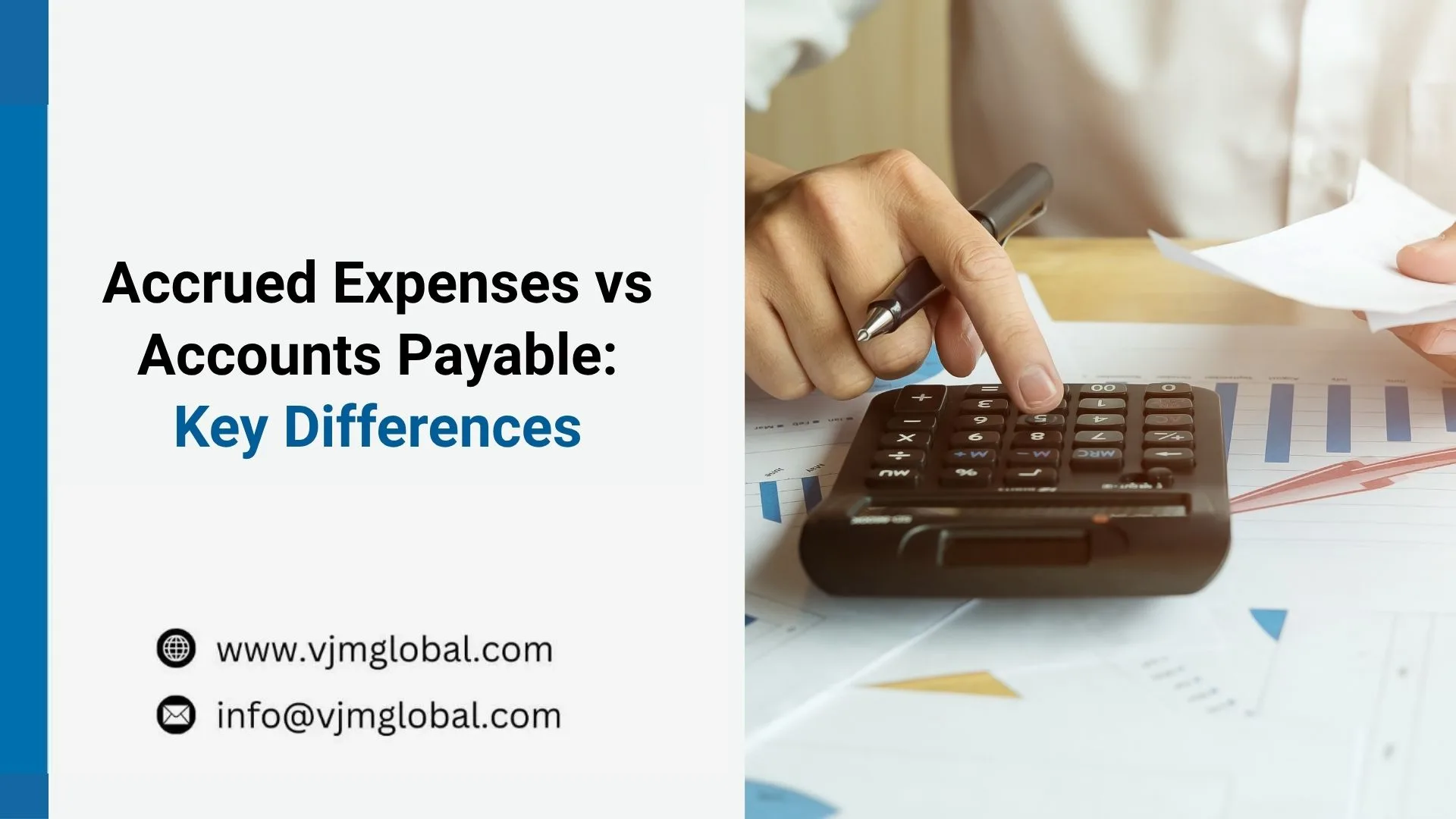Financial clarity strengthens every part of a business. From budgeting to forecasting, success relies on knowing where money flows and what obligations remain. One common area of confusion lies in how companies classify short-term liabilities, especially when comparing accrued expenses vs accounts payable.
Though both appear under current liabilities, their nature, timing, and treatment differ in key ways. Recognizing these differences helps businesses maintain accurate records, avoid misstatements, and plan with precision.
In fact, a 2024 Deloitte CFO Signals survey reported that 72% of CFOs increased their focus on working capital and cash optimization due to ongoing market uncertainty.
This article provides a straightforward explanation of accrued expenses versus accounts payable, explaining how each affects financial reporting and strategic planning for U.S.-based businesses.
TL;DR
- Accrued expenses are unbilled liabilities recorded through journal entries to match costs to the correct period, ensuring accurate financials under accrual accounting.
- Accounts payable are formal, invoiced obligations for received goods or services, tracked with payment terms to manage supplier ties and cash flow.
- Mixing up accrued expenses and accounts payable skews short-term liabilities, which can harm budgeting, forecasting, and audit compliance.
- Delayed payments can harm credit, vendor trust, and lead to penalties or supply chain issues.
What Are Accrued Expenses?
Accrued expenses represent costs a business has incurred within an accounting period but has not yet paid. Under the accrual accounting method, companies record these expenses even if no cash transaction has occurred. This means the business acknowledges its obligation before receiving an invoice or making a payment.
Adhering to the accrual basis ensures that financial statements present a complete and accurate representation of expenses for the period, regardless of when payments are made. This approach aligns costs with the revenues they help generate, offering US businesses and entrepreneurs a more precise view of their financial performance and obligations.
Common examples include:
- Salaries and wages earned but not yet paid
- Interest on loans accrued but unpaid
- Utilities or rent used but billed later
- Taxes owed but not yet settled
Practical example:
Suppose a company’s employees earned $300,000 in wages for the last week of March, but payday is in the first week of April. Although payment occurs in April, the company records $300,000 as an accrued expense in March to accurately reflect the true labor costs for that period.
Accrued expenses appear on the balance sheet as current liabilities and are reversed in the next period once payment is made. This ensures accurate and compliant financial reporting.
Also read: Key Differences Between Accounts Payable and Accounts Receivable
What Is Accounts Payable?
Accounts payable (AP) represents the outstanding amounts a business owes to suppliers, vendors, or creditors for products and services already received but not yet paid. These obligations are classified as short-term liabilities and are recorded on the company’s balance sheet under the category of current liabilities.
For US businesses, managing accounts payable efficiently is crucial. It helps preserve strong supplier relationships, maintain healthy cash flow, and avoid late payment penalties. When a business purchases inventory, office supplies, or services on credit, the amount owed is recorded as accounts payable.
Instead of immediate payment, the company receives an invoice outlining the payment terms, which are commonly 30, 60, or 90 days. This allows the business to utilize the goods or services while conserving cash for other operational needs.
Practical example:
A retail store orders $200,000 worth of merchandise from a supplier with 60-day payment terms. The store receives the products immediately and records the invoice under accounts payable. The store now has 60 days to sell the merchandise and generate revenue before paying the supplier.
Accurate tracking of AP involves recording invoices, verifying legitimacy, and scheduling payments to avoid late fees or vendor issues. Strong AP processes can also help businesses access early payment discounts, negotiate better terms, and strengthen financial control.
Suggested Read: Notes Payable vs Accounts Payable: Key Differences Explained
Now, let us understand the difference between accrued expenses and accounts payable below.
Difference Between Accrued Expenses and Accounts Payable
The contrast between accounts payable versus accrued expenses stems from the timing of recognition and the presence of documentation.
Here’s a clear comparison table outlining the difference between accrued expenses and accounts payable:
|
Basis of Comparison
|
Accrued Expenses
|
Accounts Payable
|
|
Definition
|
Expenses incurred but not yet invoiced or paid
|
Amounts owed for goods/services received and invoiced
|
|
Trigger
|
Recognized based on economic activity (no invoice)
|
Recognized when an invoice is received from a vendor
|
|
Timing
|
Recorded at period-end as part of accrual adjustments
|
Recorded upon receipt of invoice
|
|
Documentation
|
No formal invoice or bill at the time of recognition
|
Invoice or bill from supplier is available
|
|
Examples
|
Accrued salaries, interest payable, utilities expense
|
Unpaid vendor invoices for inventory or services
|
|
Estimation Required?
|
Yes
|
No
|
|
Payment Terms
|
Not yet specified
|
Usually has agreed payment terms (e.g., Net 30)
|
|
Accounting Entry
|
Journal entry required to accrue liability
|
Entry made based on invoice received
|
|
Reporting Impact
|
Ensures matching principles in accrual accounting
|
Tracks current liabilities and supports cash flow planning
|
While both represent money owed, they serve different roles. Accrued expenses account for unbilled obligations. Accounts payable reflect formal, documented liabilities. Grouping them together may result in misclassification, distorting the business’s actual exposure.
You Might Also Like: Operating Income Vs. EBITDA: Understanding The Differences
So, what happens when you don't settle the accrued expenses and accounts payable for your business? Let us understand below.
Impact of Not Settling Accrued Expenses and Accounts Payable on Time
Delaying payments on accrued expenses and accounts payable can put your business at serious risk, both operationally and financially, as well as to its reputation. For entrepreneurs and growing companies in the US, these consequences are especially costly:
- Supplier Relationships and Business Credit Take a Hit: US vendors typically extend terms of 30 or 60 days with the expectation of timely payment. Late payments can damage trust, lead to reduced credit lines, or prompt vendors to demand payment in cash upfront. Frequent delays can lower your business credit score and limit access to loans or supplier credit.
- Cash Flow Becomes Harder to Manage: Holding off on payments might provide short-term relief, but it complicates cash flow forecasting. A buildup of outstanding bills can lead to large lump-sum outflows that interrupt payroll, rent, or inventory purchases. This is especially risky for small businesses with tight margins.
- Late Fees and Financing Costs Add Up: Many US-based suppliers charge late fees or interest for overdue invoices. These expenses reduce your profit margins and raise the overall cost of doing business.
- Legal and Contract Risks Increase
Failing to adhere to agreed-upon payment terms can expose your business to breach-of-contract claims or small claims court proceedings. In specific industries, such as healthcare, finance, and government contracting, non-compliance can lead to audits or regulatory action. - Reputation Takes a Hit: Reputation matters in the US business environment. Frequent payment delays can brand your company as high-risk. That perception spreads quickly and can affect future partnerships, investor interest, and customer trust.
- Supply Chain Disruptions Slow You Down: Vendors may halt deliveries, delay service, or revoke credit lines if payments remain pending. This can lead to production slowdowns, fulfillment delays, or missed deadlines, all of which negatively impact revenue.
- Financial Reporting Becomes Unreliable: When liabilities are left unpaid, financial statements no longer reflect the true state of the business. This distorts budgeting, tax planning, and performance tracking, resulting in poor decision-making.
Now that we understand everything about accrued expenses and accounts payable, let's explore how VJM Global assists CPA firms in managing both.
Also Read: Understanding the Differences Between GAAP and GAAS
How VJM Global Supports CPA Firms with Accruals and Payables
Understanding the key differences between accrued expenses and accounts payable is essential for accurate financial reporting and informed cash flow management. While both represent outstanding obligations, accrued expenses are incurred but not yet invoiced, whereas accounts payable are recorded once the invoice is received.
Getting this distinction right affects how firms assess liabilities, plan budgets, and stay audit-ready. Misclassifications can lead to distorted financial statements and informally made decisions.
At VJM Global, we help U.S. CPA firms streamline expense reporting and improve financial accuracy through specialized offshore accounting solutions:
- Accrual Accounting Expertise: Our experienced offshore accountants are trained in U.S. GAAP and IFRS standards, helping CPA firms properly record accrued expenses and manage timing differences with precision.
- Improved Cash Flow Visibility: By clearly categorizing short-term liabilities, we help firms generate more reliable cash flow forecasts. This clarity is crucial for client advisory and financial planning.
- Scalable Offshore Staffing: Reduce operational costs by up to 50% without compromising quality. Our flexible staffing solutions support everything from day-to-day bookkeeping to advanced financial statement preparation.
- Audit-Ready Documentation: We maintain meticulous documentation trails that ensure accrued expenses and payables are audit-compliant. This reduces the risk of financial discrepancies and penalties.
- Customized Workflow Integration: Our offshore teams adapt to your systems and processes, providing real-time updates and smooth collaboration with your onshore staff.
- Trusted by CPA Firms Nationwide: With a 95% client retention rate, VJM Global is the go-to partner for firms seeking to improve efficiency, accuracy, and profitability in their accounting operations.
Stay ahead of complex reporting requirements and strengthen your client service offering.
Partner with VJM Global to take control of your firm's financial reporting and confidently manage accrued liabilities and accounts payable. Contact VJM Global today to explore how our offshore accounting experts can support your growth.
FAQs
1. What is the main difference between accrued expenses and accounts payable?
Ans. The key difference lies in timing and documentation. Accrued expenses are incurred but not yet invoiced, such as unpaid wages at the end of a month. Accounts payable refers to obligations backed by received invoices, like supplier bills. Both are liabilities, but accrued expenses are based on estimates, while accounts payable are linked to actual bills.
2. How are accrued expenses and accounts payable presented on the balance sheet?
Ans. Both appear under current liabilities but as separate line items. Accounts payable entries are based on vendor invoices and have clear due dates. Accrued expenses are estimated amounts for costs that have been incurred but not yet billed, such as salaries or utility expenses. This distinction affects how each is tracked and reported.
3. Can accrued expenses become accounts payable later?
Ans. Yes, and it happens frequently. A company may accrue an expense at the end of a period to match costs with revenues. Once the invoice is received, the accrued liability is reversed, and an accounts payable entry is recorded. For example, a $5,000 legal fee estimated in June becomes payable once the invoice arrives in July.
4. Why is it important to distinguish between the two?
Ans. Accurate classification supports proper financial reporting. Accrued expenses ensure expenses are recognized in the correct period, while accounts payable help manage vendor payments and cash flow. Confusing the two can lead to inaccurate profit estimates or delayed payments.
5. Are accrued expenses always short-term liabilities like accounts payable?
Ans. In most cases, yes. Both are typically settled within a year and are classified as current liabilities. However, some accrued expenses, such as deferred compensation, can extend beyond 12 months. Still, for typical business operations, both are short-term obligations.













